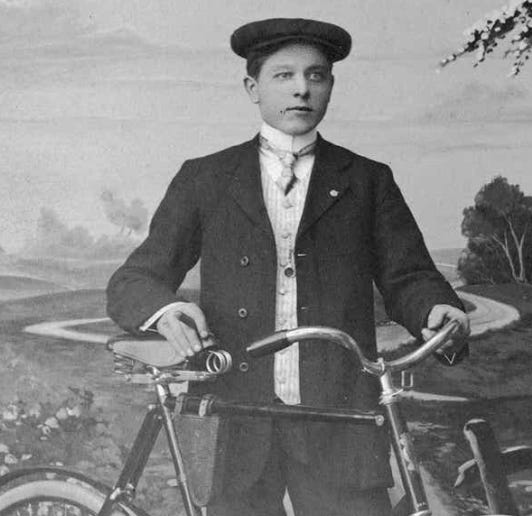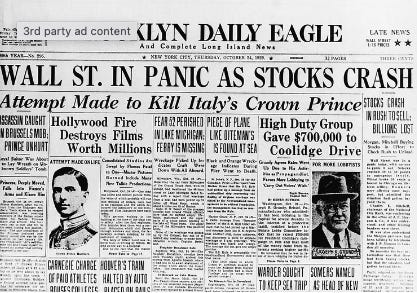When the 1929 great depression ruined his carpentry business
He focused on building a tiny toy company that is now worth $9 billion
It’s a toy that is on every child’s Christmas list. Or given as a birthday gift.
And when I say given, I mean in big numbers too … like there are over 400 billion pieces in the world.
A set is sold every 7 seconds.
If the little plastic pieces were real people, they’d be the largest population on Earth with 4 billion. That’s almost double the population of China and India combined.
And although it’s a toy, you can configure a set of six into 915 million ways.
The toy I’m talking about has been around for over 91 years and has grown into one of the most popular brands in the world.
And it all began when a young man named Ole Kirk Kristiansen at the age of 24 bought a small carpentry shop in Billund, Denmark for around $1,433 dollars.
A Little of This, A Little of That
The village of Filskovand, Jutland, is located in the northern part of Denmark. In fact if you visit the Skagen, you’d be standing where the Baltic and North seas meet.
And you’d likely see some historic buildings and ports such as Aarhus, which has been preserved and looks pretty much like it did back in 16th century.
Jutland is also where Ole Kirk Kristiansen was born on April 7, 1891. He was the tenth child of 12 born to Jens Niels Kristiansen and Kristine Kristiansen. His father Jens or J.C. as he was known to family and friends, was a teacher for the small schoolhouse in Jutland.
The family didn’t have a lot of money and lived in a rather small house … one not ideally suited for a family of 14 people in total.
But they made it work.
And work would be the backbone that kept this family together.
When Ole Kirk turned seven, he got a job herding sheep and cows for neighboring farms. And when he wasn’t doing that, you’d find him cleaning out the stables and any other odd jobs that came up.
In fact when all 12 of the children were old enough to work, that’s exactly what they did. A little of this and a little of that is how the family made enough money for food and clothing.
For instance, Ole Kirk’s brother Kersten found work as a carpenter. Ole actually found that more appealing than herding a bunch of cows, so eventually he became an apprentice carpenter to his brother.
In 1911 when he was 20 years of age, Ole received his journeyman’s certificate. He was ready to make his mark on the world as a newly minted carpenter.
Except that would have to wait because before he could do that, he had to join the military (as was required back then). He did so as an infantryman at the Citadel in Copenhagen. The Citadel was founded in 1626 by Danish King Christian the Fourth.
It’s a star shaped fortress with a grassy mound and surrounded by a moat. It’s where many soldiers trained when they joined the military.
Once Ole Kirk’s military training was completed, he then set out to do carpentry work. But once again that work was put on hold because when the war broke out in 1914, Ole Kirk was called up to serve.
He was deployed from 1914 through 1915. And when that tour of duty was officially completed, Ole Kirk was once again ready to begin his carpentry career.
The first thing he did was buy a small carpentry shop in Billund, Denmark. The second thing he did was marry Kristine Sorensen, his longtime girlfriend.
You Shouldn’t Play With Fire
The two set up a home in Billund, which back then was a community consisting of a handful of small farms, grocery shop, dairy, blacksmith, inn, mission hall, school, co-operative shop, and a joinery factory.
Ole Kirk’s woodworking shop kept him quite busy making doors, windows, kitchen cabinets, cupboards, chests of drawers, tools for digging peat, bodywork for carts, and sometimes even coffins.
He was gaining quite a reputation for the quality of craftsmanship he put into everything he made. In fact he was even asked to work on other larger projects such as houses, farm buildings, the dairy at Billund and at Randle, mission halls and a new gallery for Grene Church.
Ole Kirk had built a thriving carpentry business, employing a handful of workers. But sometimes things happen, like when children play with matches, and that turns your growing business into a pile of ashes.
On Sunday, April 27, 1924, while Ole Kirk and his wife Kristine were taking an afternoon nap, their sons Godtfred, age 4 and Karl Georg, age 5 were playing in the workshop.
The two boys grabbed a pack of matches to light a fire in the glue heater and by accident they also set fire to some wood shavings. As you can imagine, it wasn’t long before that little fire became a towering inferno.
That woke both Ole Kirk and Kristine from their slumber and they immediately rescued both boys from the woodshop before the entire structure burnt to the ground.
Well Dear Reader what’s a carpenter to do when his shop is now nothing more than a smoldering pile of wood? Well, you build a new one. You have too, it’s your only source of income.
With lots of determination and help from neighbors, a few months later, Ole Kirk’s new woodshop was completed. He was back in business.
But five years later, he would be forced to shut his little carpentry business down altogether.
Black Friday the World Over
In October 1929 something unexpected and tragic happened that would be felt the world over … the Wall Street stock market in New York crashes.
The roaring 20’s started with an epic boom and ended with a cataclysmic bust. Entire industries collapsed. Business, both large and small struggled to stay afloat.
Employers began to lay off workers. The country's gross national product declined by over 25 percent within a year, and wages and salaries declined by $4 billion. Unemployment tripled, from 1.5 million at the end of 1929 to 4.5 million by the end of 1930.
Both the USA and UK place restrictions on imports, which brought the crisis directly to Danish farming communities in 1930. Butter and bacon represented a huge portion of Danish exports. And with restrictions in place, prices started to fall sharply. Life became very difficult for Danish farmers. In fact many were forced from their farms.
The economic crisis also had serious consequences for Ole Kirk Kristiansen. Farmers and smallholders, his most important customers, could no longer afford to have carpentry work done. So 1931 he had no option left but to let his small gaggle of workers go.
With no customers for his carpentry work, Ole Kirk Kristiansen was forced to figure out a new way to use his woodworking skills.
Luckily, he happened to read a magazine article on how manufacturing readily marketable products, such as stepladders, ironing boards and other utility items were now essential household products.
And the same article also mentioned how children need toys to keep them occupied while their parents looked for jobs.
Ole Kirk knew right then and there this was his new calling. But the stock market crash had wiped out his savings, and he had very little cash on hand.
So he asked his brothers and sisters for a loan in the amount of $430. It’s money he would use to get his woodworking shop back in operating condition.
And for the next few years, Ole Kirk Kristiansen manufactured the same household items he had read about in the magazine.
But near the end of 1935, Ole Kirk decided he had made more than his share of utility items. He wanted to make something different, something a bit unusual and something fun. Ole Kirk never forgot the part of the magazine article that mentioned making toys for children.
And in that split second decision, Ole Kirk turned his woodworking shop into the town’s toy maker shop.
Stackable Wooden Toys
Ole Kirk was all in for toys. Any toy he could think of, he made out of wood including piggy banks, pull toys, cars and trucks, and tiny houses.
It wasn’t necessarily a profitable endeavor for Ole Kirk. And sometimes he had to supplement his income by making practical furniture that he sold to local farmers.
But he never stopped making toys. In fact he even made wooden yo-yos for a brief period of time. And to reduce waste, he used the leftover yo-yo parts as wheels for toy trucks. And those toy trucks could easily be taken apart and reassembled in different ways.
As Ole Kirk Kristiansen continued to concentrate on toy production, he realized that the company should have another name other than Billund Woodworking Factory.
So he organized a competition among his employees, looking for suggestions for a good name for the up and coming toy company. The winner would receive a bottle of Ole Kirk’s homemade wine.
I can’t tell you if the bottle of wine was a real motivator or if the employees were eager to help rename the company, but everyone entered the competition … including Ole Kirk himself.
Turns out, he’d win the competition hands down. All he did was combine two Danish words that translate into play well: LEG GODT.
But to make it easier for everyone to pronounce, Ole Kirk shortened the name to LEGO. The new name of his toy company was officially used for the first time in January 1936.
Ole Kirk continued to make wooden toys that could be taken apart and reassembled until 1949. That’s when plastics became available in Denmark.
In the same year, the Lego Group began producing blocks of plastic bricks, which could be put together in all kinds of ways. The Lego blocks were a huge hit with children everywhere.
Now you can buy all kind of LEGO sets including Star Wars, Harry Potter, Jurassic World, and Pirates of the Caribbean to name just a few. You can even buy a LEGO world map with over 11,695 interlocking pieces.
From Son to Son
The company that Ole Kirk started some 90 years ago, has been passed down from father to son for several generations. It is now owned by Kjeld Kirk Kristiansen, a grandchild of Ole Kirk.
Kjeld Kirk Kristiansen has a 75% stake in the company which he splits evenly with his three children, together controlling the business.
More than 220 million Lego sets are sold around the world each year. That works out as about 7 Lego sets sold per second.
In 2022, the LEGO brand was valued at approximately $9.1 billion U.S. dollars.
Awesome Quotes by Awesome People
“With a bucket of LEGO, you can tell any story. You can build an airplane, a dragon or a pirate ship. It’s whatever you can imagine.” — Christopher Miller






